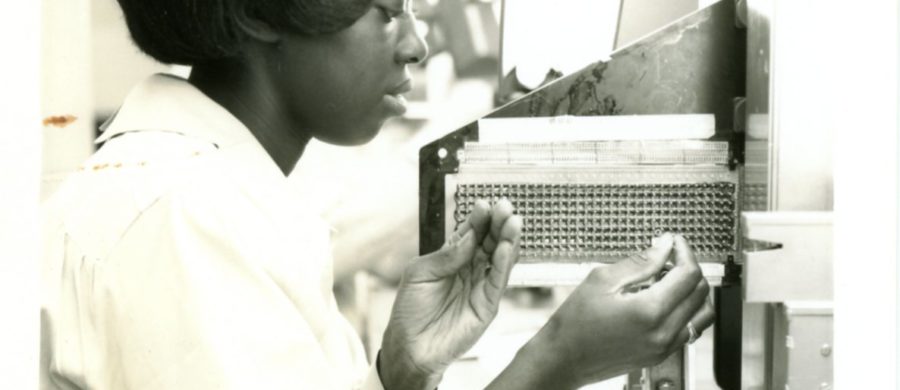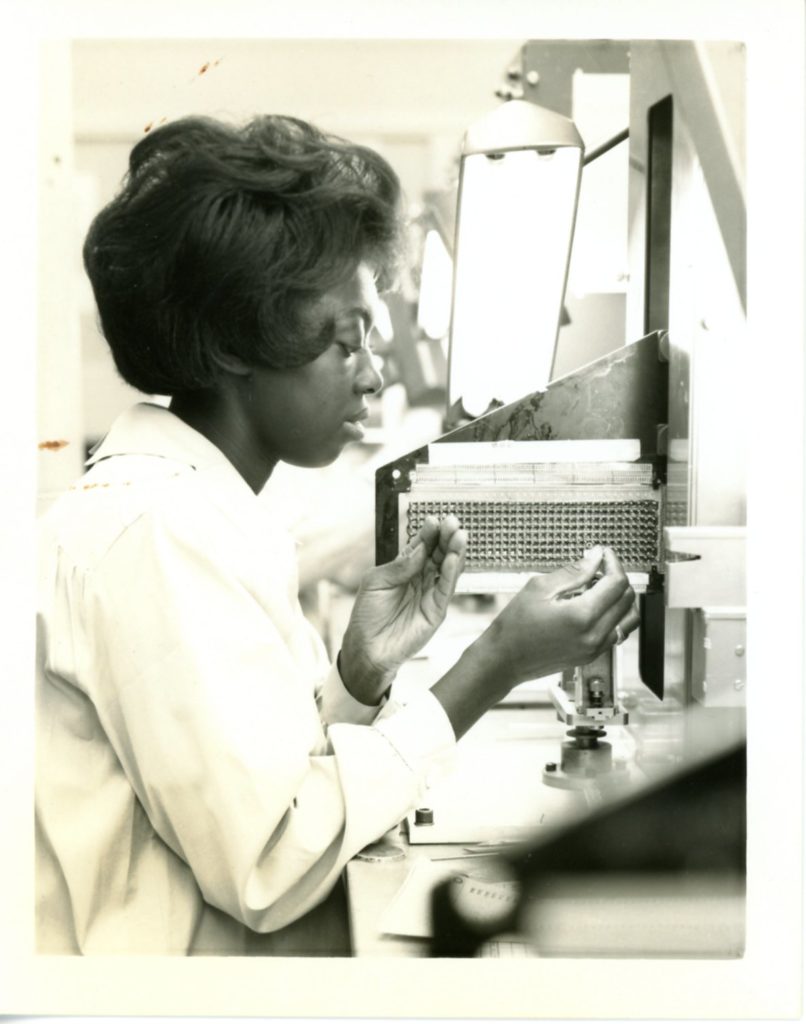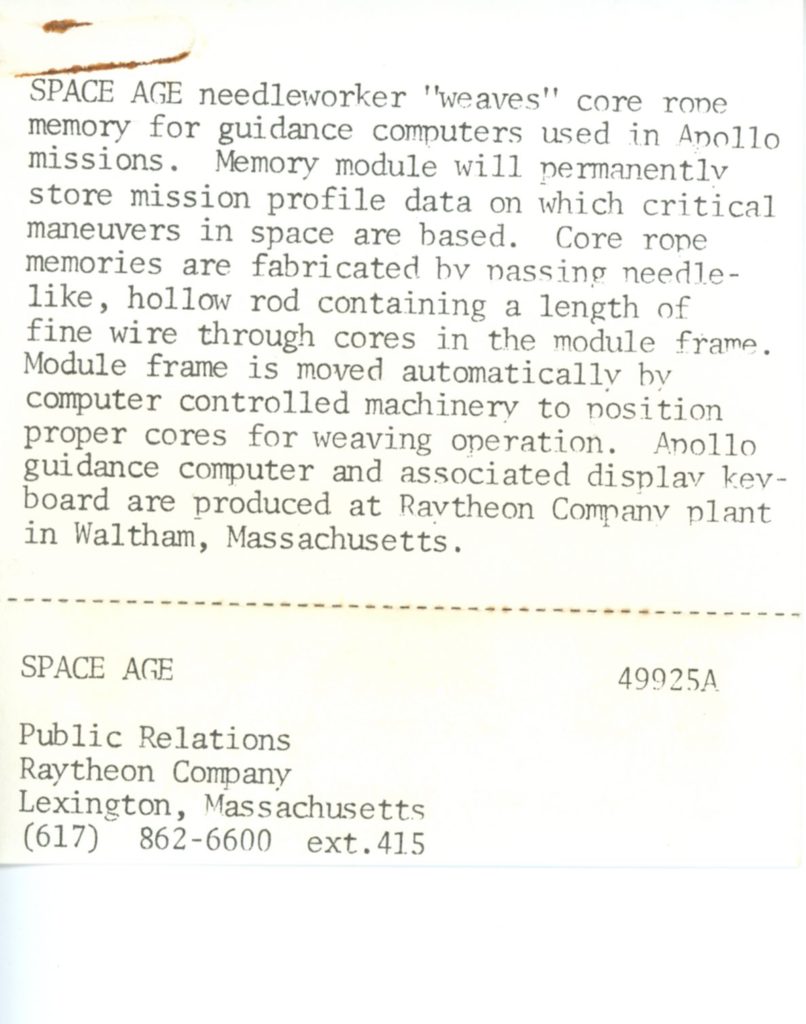
Making Core Memory – An experiment in troubling computing histories
Technology’s Stories v. 7, no. 2 – 10.15763/jou.ts.2019.06.13.02
PDF: Shorey_Making Core Memory
In a two-minute clip from the docuseries Moon Machines, two women in white smocks pass a needle back and forth through a matrix of eyelet openings.[1] Sitting under task lamps in a Raytheon facility outside of Boston, they are making “core memory” for the Apollo Guidance Computer. They thread the wire through the ferrite cores and code one bit of information into each connection. It looks similar to weaving.
But, does core memory manufacturing just look like weaving to us, as researchers? Or was it thought of as weaving by the people who were involved in the process? In interviews we conducted with core memory engineers from early computing firms, weaving comprised a novel and unfamiliar way of conceptualizing the wiring of magnetic cores. To describe this process, the engineers often used the generic term “assembly” in their reflections, a term typically deployed to characterize the manufacturing of computer components more broadly.[2] “Until this discussion I had never heard of ‘stringing cores’ as a weaving problem,” explained Frederick Dill, pioneering engineer and co-inventor of the semiconductor laser. In later communication with us, he elaborated: “Your focus on ‘weaving’ is an equally valid viewpoint, but a different one. It sort of assumes that some particular configuration of weaving will produce what is needed … which is totally correct.”[3]
Despite Dill’s apparent unfamiliarity with weaving, textile metaphors pervaded descriptions of the Apollo core memory manufacturing process to the public during the 1960s. When Raytheon manager Ralph Ragan explained the challenge of building the Apollo Guidance Computer (AGC) to the press, he made this link explicit. “We have to build, essentially, a weaving machine,” he asserted.[4] Press kit photos described core memory being made by “space age needleworkers” who were “threading” wires.[5] In an introductory video made by MIT, the reporter describes the program code as being captured in “the pattern of the sewing.”[6] Internally, Raytheon’s report on the AGC programs also referred to their “weaving” and testing.[7]
Figure 1. An unknown woman weaves core memory in a photograph from a Raytheon Apollo 11 Press Kit. (Right) Photo caption describing the woman as a “space age needleworker.” Raytheon photos courtesy of the collection of David Meerman Scott, author of Marketing the Moon: The Selling of the Apollo Lunar Program (Cambridge: MIT Press, 2014).
The language of weaving and textiles have an explanatory power. They draw our attention to contributions that exceed the material capacities of electronic components. As opposed to more neutral terms like “operation” and “assembly,” weaving connects us to lineages of women’s work thousands of years old.[8] It challenges the widespread omission of embodied practice — or bodies at all — within core memory literatures. It locates women, many of whom are women of color, as central contributors to computing.
These connections between weaving and wiring, textiles and computing, inspired Making Core Memory, an exploratory technology history project we’ve made available for you at makingcorememory.org. With Making Core Memory, we use weaving and textiles as not only metaphors but also a means of historicizing computing. We invite Technology’s Stories readers to revisit the story of the core memory weavers as a way to explore under-recognized contributions to early computer innovation.
The software programs for the Apollo moon missions were permanently stored through hard wiring the code into “core rope memories”. Each core rope comprised wires of two types: address wires and sense wires.[9] The sense wire was especially important. It was woven through the cores in a pattern, physically encoding the 1s and 0s of binary code. When the wire passed through a ferrite core it would be read as 1. When it passed around the core (missing it completely) it would be read as a 0.[10] The weavers had the help of a machine that would let them know which cores needed threading.[11] By inviting you to weave core ropes yourself, we hope that you ask new questions of your practice.
In order to rework who builds our worlds today, we need to rework how we tell stories about our pasts. In Saidiya Hartman’s words, “Inheritances are chosen as much as they are passed on. The past depends less on ‘what happened then’ than on the desires and discontents of the present. Strivings and failures shape the stories we tell” — and, we might add, the futures we create.[12]
Daniela Rosner is an Assistant Professor in Human Centered Design & Engineering (HCDE) at the University of Washington and co-director of the Tactile and Tactical Design (TAT) Lab. Her research investigates the ethical and participatory dimensions of design methods, particularly within sites historically marginalized within engineering cultures.
Samantha Shorey is a doctoral candidate in Communication at the University of Washington and a research associate at the Tactile and Tactical Design Lab in the department of Human Centered Design & Engineering (HCDE), where she studies the intersection of technology innovation and craft.
Bibliography
Barber, E. J. W. Women’s Work: The First 20,000 Years : Women, Cloth, and Society in Early Times. 1st ed. New York: Norton, 1994.
Ceruzzi, Paul. “The ‘Rope Mother’ Margaret Hamilton.” Smithsonian National Air and Space Museum, March 11, 2016. https://airandspace.si.edu/stories/editorial/rope-mother-margaret-hamilton.
Computer for Apollo. MIT museum collections, 1965. https://www.youtube.com/watch?v=ndvmFlg1WmE.
Dill, Fredrick. Interview by Daniela K. Rosner, March 18, 2017.
Hartman, Saidiya V. Lose Your Mother: A Journey along the Atlantic Slave Route. 1st ed. New York, NY: Farrar, Straus and Giroux, 2007.
Mindell, David A. Digital Apollo: Human and Machine in Spaceflight. Inside Technology. Cambridge, MA: MIT Press, 2008.
MIT Science Reporter—”Computer for Apollo” (1965). Accessed May 6, 2019. https://www.youtube.com/watch?v=ndvmFlg1WmE.
Moon Machines. Docuseries, 2008.
Raytheon Company Equipment Division. “Apollo Guidance Computer Program Block 1 (100) and Block II,” December 31, 1969. Apollo Lunar Equipment Collection. Smithsonian National Air and Space Museum.
Rosner, Daniela K., Samantha Shorey, Brock R. Craft, and Helen Remick. “Making Core Memory: Design Inquiry into Gendered Legacies of Engineering and Craftwork.” In Proceedings of the 2018 CHI Conference on Human Factors in Computing Systems – CHI ’18, 1–13. Montreal QC, Canada: ACM Press, 2018. https://doi.org/10.1145/3173574.3174105.
Scott, David Meerman, and Richard Jurek. Marketing the Moon: The Selling of the Apollo Lunar Program. MIT Press, 2014.
Weaver, Dick. Interview by Daniela K. Rosner, March 8, 2017.
Woodworth, Lee. Interview by Samantha Shorey, March 5, 2019.
[1] Moon Machines.
[2] Weaver, interview.
[3] Dill, interview.
[4] Mindell, Digital Apollo.
[5] Scott and Jurek, Marketing the Moon.
[6] MIT Science Reporter—”Computer for Apollo” (1965).
[7] Raytheon Company Equipment Division, “Apollo Guidance Computer Program Block 1 (100) and Block II.”
[8] Barber, Women’s Work.
[9] Raytheon Company Equipment Division, “Apollo Guidance Computer Program Block 1 (100) and Block II.”
[10] Ceruzzi, “The ‘Rope Mother’ Margaret Hamilton.”
[11] Woodworth, interview.
[12] Hartman, Lose Your Mother, 100.


